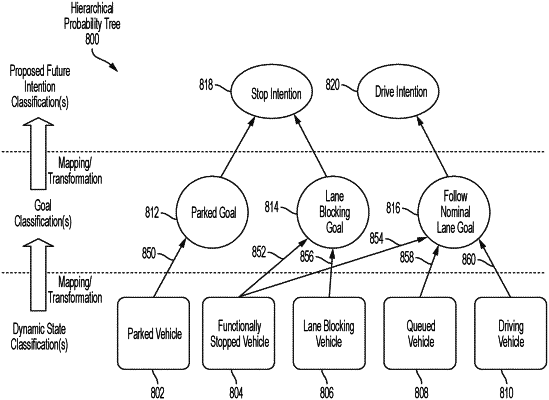| CPC B60W 30/0956 (2013.01) [B60W 30/09 (2013.01); B60W 50/0097 (2013.01); B60W 60/001 (2020.02); B60W 2420/42 (2013.01); B60W 2420/52 (2013.01); B60W 2420/54 (2013.01); B64C 39/024 (2013.01); B64U 2201/10 (2023.01)] | 15 Claims |

|
1. A method for operating an autonomous vehicle, comprising:
using sensor data, by the computing device, to track an object that was detected in proximity to the autonomous vehicle;
classifying, by the computing device, the object into at least one dynamic state class of a plurality of dynamic state classes, wherein at least two dynamic state classes of the plurality of dynamic state classes indicate different possible reasons for any object being stationary, and a first one of the at least two dynamic state classes comprises a blocking object class and a second one of the at least two dynamic state classes comprises a parked vehicle class, a functionally stopped vehicle class, or a queued vehicle class;
using, by the computing device, a result from said classifying to determine at least one predicted future intention of the object by:
accessing, by the computing device, a single hierarchical probability tree comprising a plurality of first nodes respectively associated with a plurality of different dynamic state classes, a plurality of second nodes respectively associated with a plurality of different goal classes, and a plurality of third nodes respectively associated with a plurality of different proposed future intention classes;
inputting the at least one dynamic state class into the single hierarchical probability tree;
transforming, by the computing device, the at least one dynamic state class into at least one goal class of the plurality of different goal classes by identifying at least one second node of the second nodes of the single hierarchical tree that is connected to at least one of the first nodes associated with the at least one dynamic state class, wherein the plurality of different goal classes specify possible current aims associated with the object;
transforming, by the computing device, the at least one goal class into at least one proposed future intention class of the plurality of different proposed future intention classes by identifying at least one third node of the third nodes of the single hierarchical tree that is connected to the at least one second node which was previously identified; and
determining, by the computing device, the at least one predicted future intention of the object based on the at least one proposed future intention class of the plurality different proposed future intention classes that is associated with the at least one third node which was previously identified; and
performing at least one next cycle of said classifying, transforming and determining to obtain at least one next proposed future intention class for the object;
combining a probability associated with the at least one proposed future intention class and a probability associated with the at least one next proposed future intention class to generate an aggregate probability;
causing, by the computing device, the autonomous vehicle to perform at least one autonomous driving operation based on the at least one predicted future intention determined for the object.
|